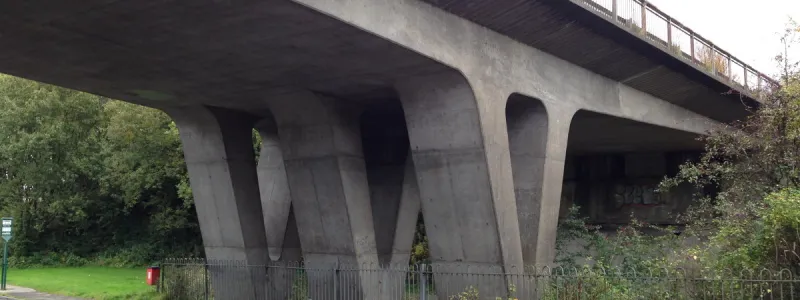Opening ceremonies to celebrate Section I were out of the question, because it was brought into use a couple of miles at a time as it was slowly finished, and the delays to the project were a downright embarrassment. So the first real opening ceremony took place on Section II, at Cefn Coed just north of Merthyr Tydfil, on 15 December 1964. James Griffiths, the successor to Lord Brecon as Secretary of State for Wales, was going to inspect the arch bridge at the Taf Fechan and had a speech to read out to a small crowd of dignitaries and journalists. There might even have been a ribbon for him to cut.
Before that could happen, though, the gathering was disrupted by a vocal (but decidedly civilised) protest from the Vaynor Parish Council Tenants Association. They were unhappy because they had been promised a path across the new Heads of the Valleys Road to reach their local school, but the path wasn't ready, and now 500 of their children had to take a detour, involving a walk along the busy A470.
The South Wales Echo's report of the opening took the protest to be very much the main event.
"When Mr James Griffiths, Secretary for Wales, arrived at Cefn Coed, near Merthyr, today to inspect the Taf Fechan bridge on the Heads of the Valleys road he was greeted by a crowd of mothers waving placards reading 'Protect our children with pathways' and 'Their lives are in your hands'."
Griffiths had no knowledge of this issue and must have been slightly bemused by it. Mrs Joyce Samuel handed him a letter, and the head teacher of the school at Ysgol-y-Graig, Dilwyn Roderick, discussed the missing footpath with him in Welsh. Mrs Samuel said that he was "very nice" and promised to look into it. The footpath was opened for the schoolchildren to use, in its slightly unfinished state, in time for their return to school after the Christmas holidays.
The missing footpath for the children of Ysgol-y-Graig wasn't the only controversy at the road's opening ceremonies. Two years later, in September 1966, Griffiths' successor Cledwyn Hughes arrived to open the final section of the new road, but its three-lane design was still an issue.
Hughes' speech for the grand opening was originally written with a passage discussing how it had been designed for excellent visibility and high speeds of 55mph, that three lanes were adequate for the traffic, and bluntly stating that it would be a perfectly safe road if drivers were careful and safe when using it. Behind closed doors, however, there was obviously some anxiety about the road that had been built and it was thought better to say nothing. Civil servants at the Ministry of Transport were extremely anxious to avoid headlines like "Minister Defends Three-Lane Deathtrap", and just a couple of days before the event, they deleted the whole section from his speech.
The road may have been finished and open to traffic but the Ministry of Transport hadn't heard the last of it just yet. Protracted negotiations over the ultimate cost of Section I, and the responsibility for it having gone so wrong, continued until 1968, when it emerged that the consulting engineers had recognised that Morgan's tender price was too low — quarter of a million pounds lower than bids placed by more experienced companies — but recommended taking it anyway.
The problems with Section I, and the associated costs, continued to stack up. It emerged that £15,000 was spent on extra excavation work, and another £11,300 on building a retaining wall that hadn't been in the original plans at all. Concrete was used to build the sewage works instead of brickwork in order to save time, adding to the cost of excavation and foundation work. Expensive macadam was used instead of cheap concrete in parts of the roadbed. There was even a mysterious request of £9,230 for "miscellaneous" expenses.
The cheap contract that had started in the first days of 1960 led to tiresome negotiations and extra expenses for almost the whole of the decade that followed.



